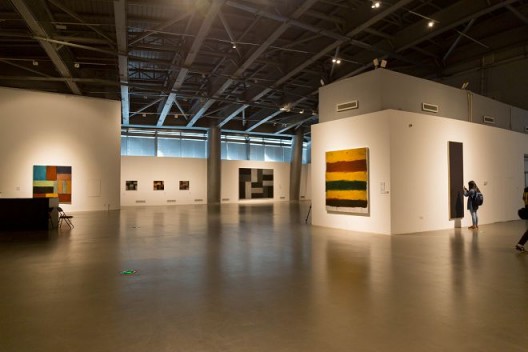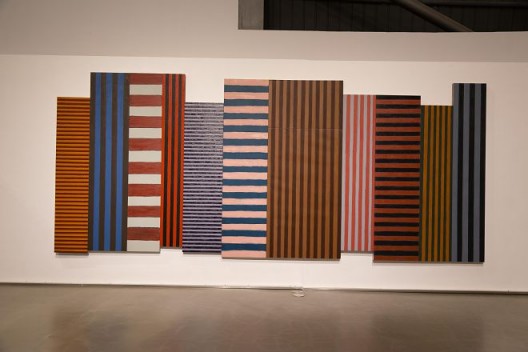Art Museum Of Nanjing University of the Arts (15 North Huju Road, Gulou District, Nanjing), Apr 8–May 8, 2016
“Resistance and Persistence” is a continuation of “Follow the Heart: the Art of Sean Scully” from last year.
With the works arranged roughly chronologically in the museum’s third-floor exhibition space, viewers will first encounter Sean Scully’s “Backcloth”(1970) in their field of vision. The variegated patterns intersect above the picture plane in an orderly manner, weaving a layered grid. Orange, cobalt, ultramarine, dark green, pitch black—the subtle overlapping of thick and slender patterns forges a sense of depth which easily leads the viewer’s eye to inquire into the hazy vista under the grid. Similar to this is “Diagonal Light” (1972), in which colorful, complex patterns interwoven on the flat surface could echo the urban landscape, or yet be a representation of forms of light—revealing the artist’s sentiment in its entirety. In “Upright Horizontals Red Black” (1979), the composition and the choice of colors tend towards the minimal; with the red and the black forming a regular pattern through regular brushstrokes, the active tension in the painting’s expression is dissolved. Matched with the frank title, the work allows one to focus only on the sparse design, the viscous texture of the paint, and a sense of cool and warmth as conveyed by the hues. The physicality of the painting’s medium is highlighted, while the artist’s continual repetition of the lines and patterns diminishes the sense of his own presence—here lies only the physical world which is not opened up for deeper contemplation. In contrast with the two earlier, more vibrant works, “Upright Horizontals Red Black” refuses the viewer any visual pleasure, while the over-simplicity of the forms does not permit much content to be conveyed.



From the mid-1970s onwards, Sean Scully began to spend more time in the US; meanwhile, his work gradually evinced minimalism to a greater degree. As Frank Stella declared, “What you see is what you see”. Minimalism avoided any metaphors, symbolism, or conveyance of emotional content—all that Abstract Expressionism affirmed—instead emphasizing the materiality of the painting. It had similarities with Pop Art—both focused on then-contemporary American life—but Minimalism removed the symbols and markers of its materials, and instead, with its clear, repetitive forms, resisted unflinching consumerism. Ample horizontal or vertical lines along with irregular rectangular forms construct the vast “Backs and Fronts” (1981). Breaking through the limits of the frame, the undulating edge and the cold, severe lines bring one back to the cosmopolitan vista brought about by America’s post-war boom—that of New York skyscrapers. Scully chipped at the surplus values of modern living and returned them as objects composing a cool, icy shell. The vast size and irregular edges bring about a sense of theatricality, impelling viewers to form a meaningful experience on their own. In “Falling Wrong” (1985), meanwhile, Scully infused the painting with sculptural elements—or one might say that he extended the minimalist challenge for the traditional binary division of painting vs sculpture. The work, in relation to the space and the lighting, in turn changed the relationship between the viewer and the artwork.
From the 1980s onwards, however, the lines in the painting grew wider; the brushstrokes daubed on gradually became distanced from their previous regularity and came to possess a flowing sense of motion. Sean Scully began to move away from minimalism to explore the fusion of body and spirit in his work. The sensorial body returned to the work, while the intentionality of the paintings grew richer. The artist again redefined his personal vision; the essence of painting was no longer the existence of things, but instead recovered the subjectivity of the artist and the expressionism of painting. In his exploration of abstraction—as suggested by the exhibition title—the artist continues to resist the experiences of his previous works, and persists with a new personal realization of art.
As the second phase of Sean Scully’s touring exhibitions in China, “Resistance and Persistence” will be shown at the Guangdong Museum of Art and at Hubei Art Museum over the coming year.



